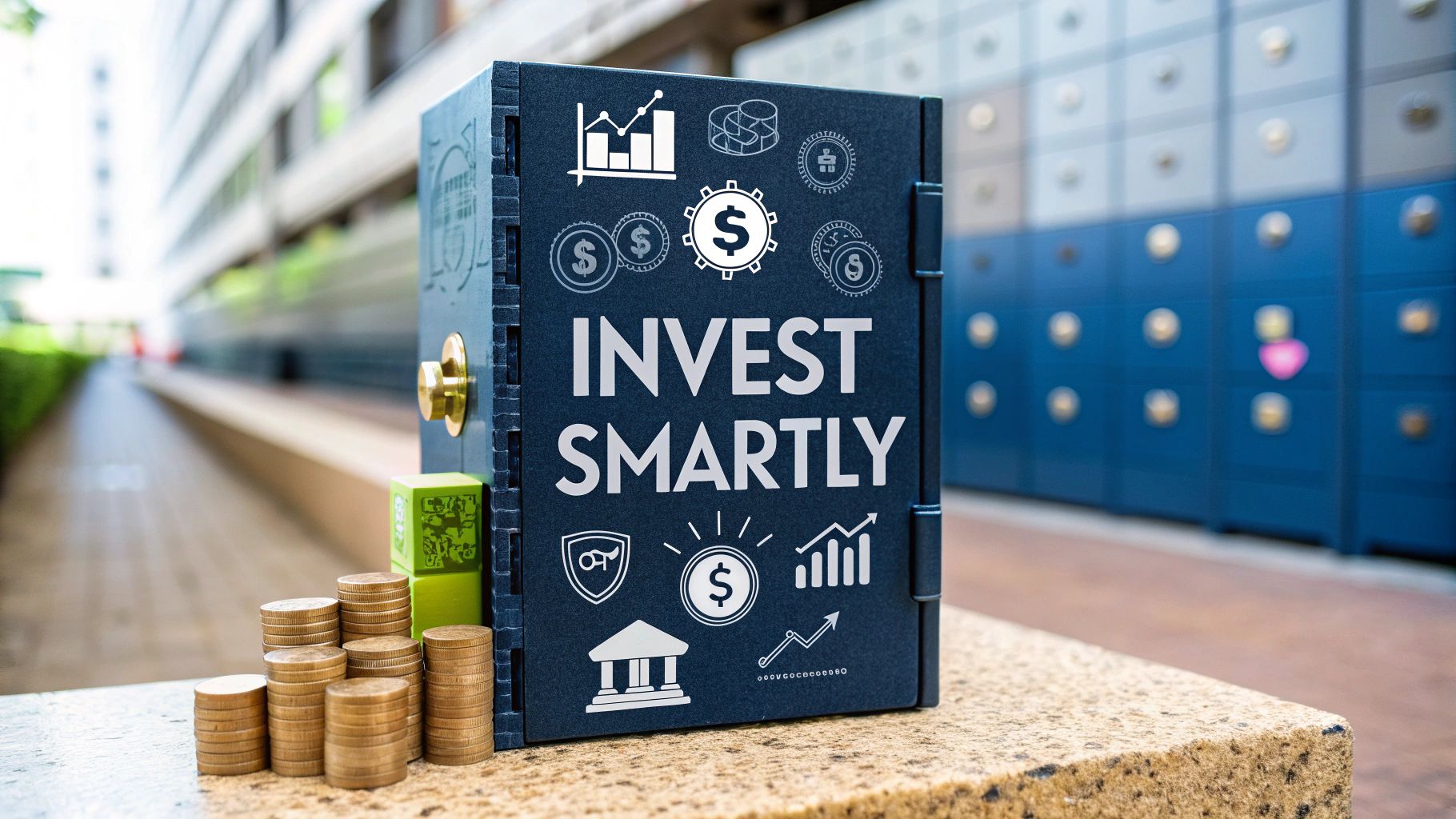The Evolution of Alternative Investments
Investment portfolios have changed dramatically over the past few decades. While stocks and bonds once dominated portfolios, alternative investments have emerged as essential tools for many investors. Let's explore how this shift happened and what it means today.
From Niche to Mainstream: A Historical Perspective
Alternative investments have deep roots in American financial history, dating back to the 18th century. Back then, investors had limited options beyond the early stock exchanges in Philadelphia (1790) and New York (1792). They turned to physical assets like real estate, art, and precious metals for diversification.
The modern alternative investment era began with hedge funds in the 1940s, followed by private equity in the 1950s. After the 2008 financial crisis, private equity saw remarkable growth, with firms like Blackstone and KKR becoming major forces in finance. Learn more about this history here.
The Rise of Hedge Funds and Private Equity
Hedge funds and private equity brought new approaches to investing. Hedge funds aimed to protect against market downturns through various strategies that could make money in any market condition. Private equity took a different path, focusing on buying and improving companies over several years to increase their value.
Modern Alternative Investments: Expanding the Toolkit
Today's investors have many more choices beyond traditional hedge funds and private equity. The options now include:
- Real estate investments
- Commodity trading
- Infrastructure projects
- Private debt funding
This variety helps investors build portfolios that match their specific needs. For instance, someone looking for steady income might invest in real estate, while another seeking bigger gains might choose private equity.
The Impact of Market Cycles
Economic ups and downs have shaped how alternative investments developed. During uncertain times, investors often look for assets that don't move in lockstep with regular markets. This has led to new investment strategies and products.
Changes in rules and what investors want have also pushed the field forward. Alternative investments keep evolving to help investors handle different market conditions. Understanding this history gives helpful perspective for building investment portfolios today.
Understanding Hedge Fund Strategies

When investors look beyond standard choices like stocks and bonds, hedge funds emerge as key players in the alternative investment space. These sophisticated investment vehicles differ markedly from typical mutual funds in both strategy and structure. Let's examine how these funds work and what makes them distinct from traditional investments.
Traditional Hedge Funds vs. Liquid Alternatives
Two main types of hedge funds have emerged to serve different investor needs. Traditional hedge funds typically charge higher fees and require longer lock-up periods, meaning investors must commit their money for a set time. These funds often use borrowed money and complex financial tools to boost potential returns, though this can mean bigger swings in value. For example, a fund might borrow to double down on a promising investment opportunity.
In contrast, liquid alternatives offer more flexibility - investors can usually withdraw money daily and fees tend to be lower. While more accessible to everyday investors, research shows liquid alternatives typically earn 1-2% less per year than traditional hedge funds. This difference stems mainly from the premium investors pay for having their money tied up longer in traditional funds. Learn more about this performance gap in this detailed analysis.
Key Hedge Fund Strategies
Different hedge funds use distinct approaches to generate returns. Here are the main strategies you'll encounter:
- Long/Short Equity: Funds buy stocks they expect to rise while selling short those they expect to fall. It's like playing both sides of the market, aiming to profit in both up and down markets.
- Event-Driven: These funds try to profit from major company events like mergers or bankruptcies. A fund might buy shares in a company being acquired, betting the deal will close at a higher price.
- Relative Value: This strategy spots and exploits small price differences between related investments. For instance, a fund might notice two similar bonds trading at different prices and bet they'll converge.
- Global Macro: These funds make big bets on economic trends, from interest rates to oil prices. They look at the big picture to find opportunities across markets worldwide.
Evaluating Hedge Fund Strategies
Picking the right hedge fund strategy depends heavily on your personal investment goals and comfort with risk. A more aggressive investor might prefer long/short equity funds that aim for bigger returns but face more market ups and downs. Someone seeking steadier returns might lean toward relative value strategies, which typically offer more consistent but modest gains.
Beyond the strategy itself, investors need to examine each fund's fees, the manager's past results, and how the fund makes investment decisions. These factors can make a big difference in your actual returns. With this foundation, you can better match hedge fund strategies to your financial goals and risk tolerance.
Performance Analysis and Portfolio Impact

To build a strong investment portfolio, you need to understand how alternative investments affect your overall performance. Simply looking at returns isn't enough - you need to examine how these investments work together and what unique benefits they bring to your portfolio mix.
Beyond Traditional Metrics: Measuring Alternative Investment Success
While return on investment (ROI) matters, it only tells part of the story for alternative investments. Take real estate, for instance - a property might show lower ROI than stocks in the short term, but provide steady income and valuable tax breaks over time.
That's why we look at risk-adjusted returns using tools like the Sharpe Ratio, which shows how much return you get for the risk you take. The correlation between alternatives and traditional investments is equally important. When alternatives move independently from stocks and bonds, they help protect your portfolio during market downturns.
Analyzing Performance in Different Market Conditions
Different types of alternative investments shine in different market conditions. Some hedge fund strategies do well when markets fall, while private equity tends to thrive during economic growth. The numbers tell an interesting story - over 30 years, adding alternatives to standard 60/40 portfolios has boosted returns while reducing risk. They've done especially well during tough times, beating the market by +29% when interest rates rise and +24% during stock market drops. For example, portfolios with 25% in alternatives have historically performed better than those with just stocks and bonds. You can find more data here.
Portfolio Impact: The Power of Diversification
Think of your portfolio like a car - relying only on stocks is like driving on one tire. Adding alternative investments gives you more tires, making your investment journey more stable. When some investments struggle, others can help offset those losses.
By mixing in investments that move differently than stocks and bonds, you can help smooth out your portfolio's ups and downs while potentially improving long-term results. This protection becomes especially valuable during market downturns.
Practical Approaches to Performance Analysis
To properly evaluate alternative investments, follow these key steps:
- Understand the Strategy: Research how the investment works, what it aims to achieve, and what risks it carries
- Consider the Time Horizon: Many alternatives need time to play out - don't judge them on short-term results
- Match the Right Benchmark: Compare performance to similar investments, not just broad market indexes
- Stay on Top of Things: Check performance regularly and rebalance your mix of investments as needed
By taking this thoughtful approach to alternative investments, you can build a portfolio that better matches your long-term financial goals.
Future Trends and Opportunities
The alternative investment landscape continues to develop in exciting new directions. Smart investors need to understand these changes to find promising opportunities and build stronger portfolios. Let's explore the key forces reshaping this space and how successful investors are adapting their strategies.
Democratization and Expanding Access
One major shift is that alternative investments are becoming available to more people. While these investments were once limited to big institutions and very wealthy individuals, new platforms and regulations now make them accessible to many more investors. For example, you can now buy fractional shares of real estate or private equity investments through online platforms with much lower minimum investments. This opens up new possibilities for individual investors to diversify their portfolios in ways that weren't possible before.
The Rise of Technology and Data
New technology is changing how we analyze and access alternative investments. Artificial intelligence helps process massive amounts of market data to spot opportunities and manage risk more effectively. At the same time, blockchain systems are making transactions more secure and efficient while potentially reducing costs. These advances give investors better tools to research opportunities and make well-informed decisions.
Shifting Investor Preferences
More investors now want their money to create positive change alongside financial returns. There's growing interest in alternative investments focused on sustainability and social impact, like renewable energy projects, social enterprises, and sustainable agriculture. This has led to rapid growth in ESG (Environmental, Social, and Governance) focused investment funds. As demand increases, we're likely to see even more options for investors who want to align their portfolios with their values.
Interest in alternative investments continues to grow as investors seek better diversification beyond traditional stocks and bonds. Learn more about these developments here. Recent market shifts, including the slowdown in private markets during 2023, have created compelling opportunities in certain areas for 2024. Assets like infrastructure, new real estate developments, and secondary market investments look particularly attractive due to their reliable cash flows.
Identifying Future Opportunities
To stay ahead in alternative investments, consider these practical steps:
- Research Emerging Sectors: Look into growing fields like fintech, biotechnology, and space technology for unique investment options
- Network with Industry Experts: Build relationships with experienced investors and fund managers to gain valuable insights
- Attend Industry Events: Join conferences and webinars to learn about new trends and strategies
- Stay Informed: Keep up with market news, regulatory changes, and technological developments affecting alternative investments
By understanding these trends and actively seeking opportunities, you can better integrate alternative investments into your portfolio for long-term growth. Taking a thoughtful approach to new developments helps you make smarter investment choices as markets continue to change.
Risk Management Considerations

Getting into alternative investments opens up new opportunities, but it comes with its own set of risks that need careful attention. Let's look at the key risks and how to manage them effectively.
Liquidity Constraints
The main difference between regular and alternative investments is how easily you can sell them. While you can quickly buy and sell stocks through your brokerage account, alternative investments often lock up your money for longer periods. For instance, if you put money into a private company, you might need to wait years before you can cash out. This limited access to your capital matters a lot if you suddenly need the money or if market conditions change quickly.
Leverage Impact
Many alternative investments use borrowed money to try to boost returns. While this can work well when investments perform as hoped, it can also multiply losses when things go wrong. Take hedge funds as an example - they often borrow money as part of their strategy. If a fund borrows to double its investment and the investment loses value, the fund's losses double too. This extra risk needs constant monitoring.
Operational Challenges
Running alternative investments takes more work than managing traditional ones. It's harder to figure out what private assets are worth since they don't have daily market prices like public stocks do. You also can't easily check how well investment managers are doing since these investments are valued less often and take longer to play out. This makes it crucial to really understand what you're getting into before investing.
Building a Robust Risk Management Framework
To handle alternative investments well, you need a solid plan. Here are the key pieces:
- Know Your Goals: Be clear about what you want to achieve and how much risk you can handle. This helps you choose the right mix of investments.
- Do Your Research: Before putting money in, check out the investment manager's past results, understand how the investment works, and know what could go wrong.
- Keep Watch: Once you invest, stay on top of how things are going. Watch performance, market changes, and any news that could affect your investment.
- Spread Things Out: Just like with regular investments, don't put all your money in one place. Mix different types of alternative investments to help protect against losses.
By understanding these risks and following a careful plan, you can make better choices about alternative investments. The key is finding the right balance between possible rewards and manageable risks. Remember to spread out your investments and do thorough research - these basic principles help navigate the complex world of alternative investing.
Implementation Strategies and Best Practices

Putting alternative investment strategies into practice takes more than just understanding the theory. You need a hands-on plan that considers everything from picking the right managers to keeping a close eye on your portfolio. Let's walk through the key steps to build and maintain a strong alternative investment portfolio.
Building Your Alternative Investment Portfolio: A Step-by-Step Guide
Here's how to create an effective alternative investment portfolio:
Set Clear Goals: Start by defining what you want to achieve. Are you looking for steady income or long-term growth? Your answer shapes your investment choices. For instance, if you're retired and want regular income, real estate might make sense. If you're younger and focused on growth, private equity could be a better fit.
Know Your Risk Level: Be honest about how much risk you can handle. Alternative investments can swing up and down quite a bit, so pick investments that won't keep you up at night.
Plan Your Timeline: Think about how long you can lock up your money. Many alternative investments need several years to play out. Private equity funds, for example, often require you to stay invested for 5-10 years.
Choose Managers Carefully: Look at potential managers' track records and experience. While past performance doesn't guarantee future results, it gives you important clues. Platforms like EquityZen can help by offering pre-screened private investment options.
Spread Your Investments: Mix different types of alternatives like private equity, real estate, and hedge funds. This helps protect your portfolio if one area struggles. A recent UBS study found that successful family offices typically invest across many different asset types.
Get the Mix Right: The amount you put in alternatives depends on your situation, but it's worth noting that many family offices now put over 50% of their money into alternative investments.
Manager Selection: Choosing the Right Partners
Finding good investment managers is crucial for success. Here's what to look for:
Do Your Homework: Research potential managers thoroughly. Check their past results, how they invest, and how they handle risk.
Look for Deep Knowledge: Make sure managers really know their specific area of investment. Expert knowledge often leads to better results.
Check Incentives: Find managers whose success depends on your success. Look for fee structures that reward good long-term performance.
Value Communication: Pick managers who keep you informed and explain things clearly. Regular updates about your investments shouldn't feel like pulling teeth.
Ongoing Monitoring and Portfolio Adjustments
Once you've made your investments, staying on top of them is key:
Check Performance: Compare how your investments are doing against similar investments.
Watch Risk Levels: Keep an eye on potential risks and adjust your portfolio when needed.
Stay Informed: Keep up with market changes that could affect your investments.
Rebalance When Needed: Sometimes you'll need to sell investments that have done very well and buy more of those that have lagged. This helps keep your portfolio aligned with your goals.
When you follow these practical steps, you improve your chances of success with alternative investments. Many successful family offices use these same approaches to manage their investments effectively.
Take the Next Step Towards Financial Freedom
Want to learn from investors who've succeeded with alternative investments? Check out The Covered Call Podcast. You'll hear from experienced investors like Luke Gromen, Rick Rule, and Doug Casey about how they built wealth through smart investments and business opportunities. Their stories and advice can help guide your own path to financial independence.

